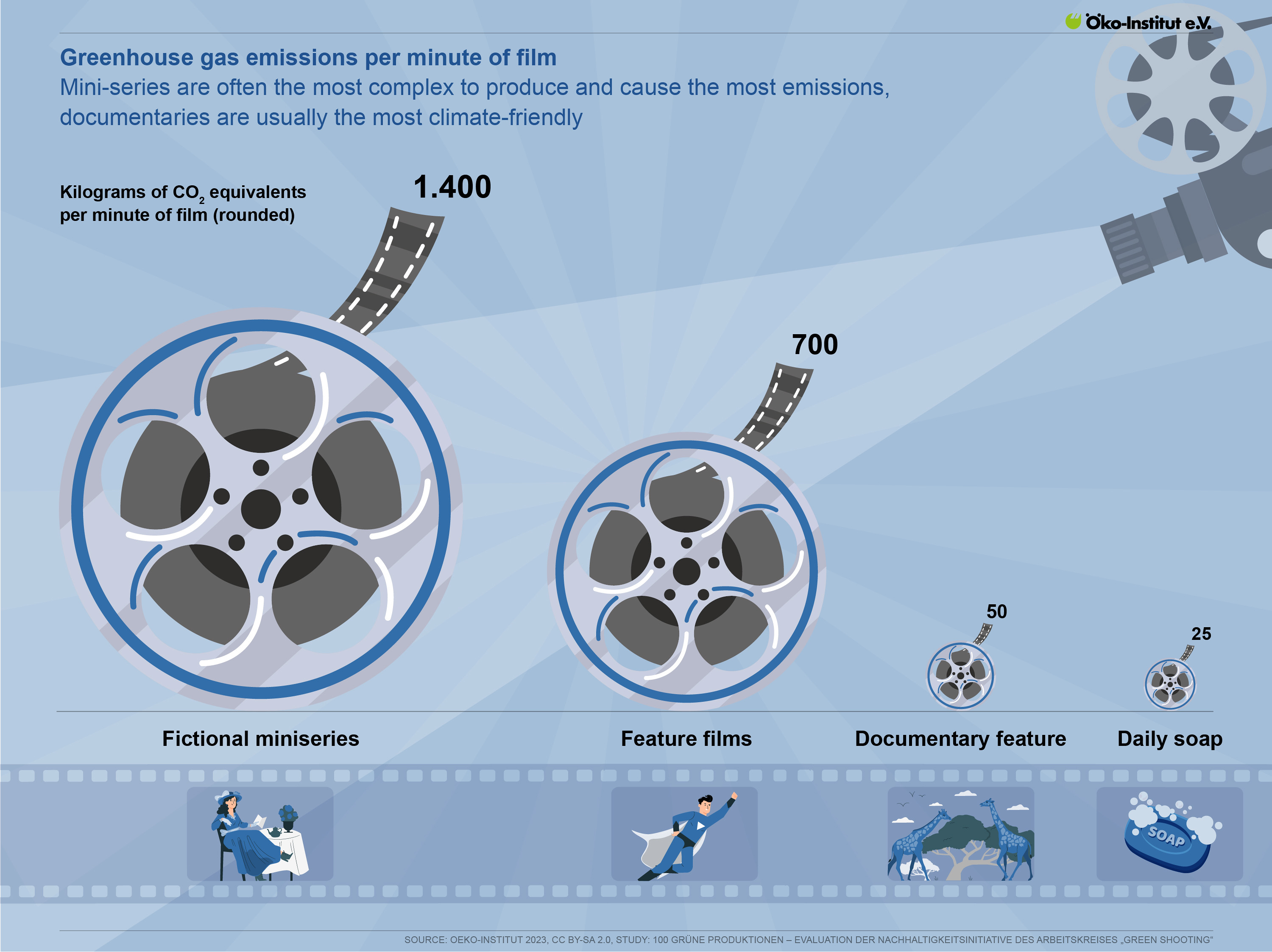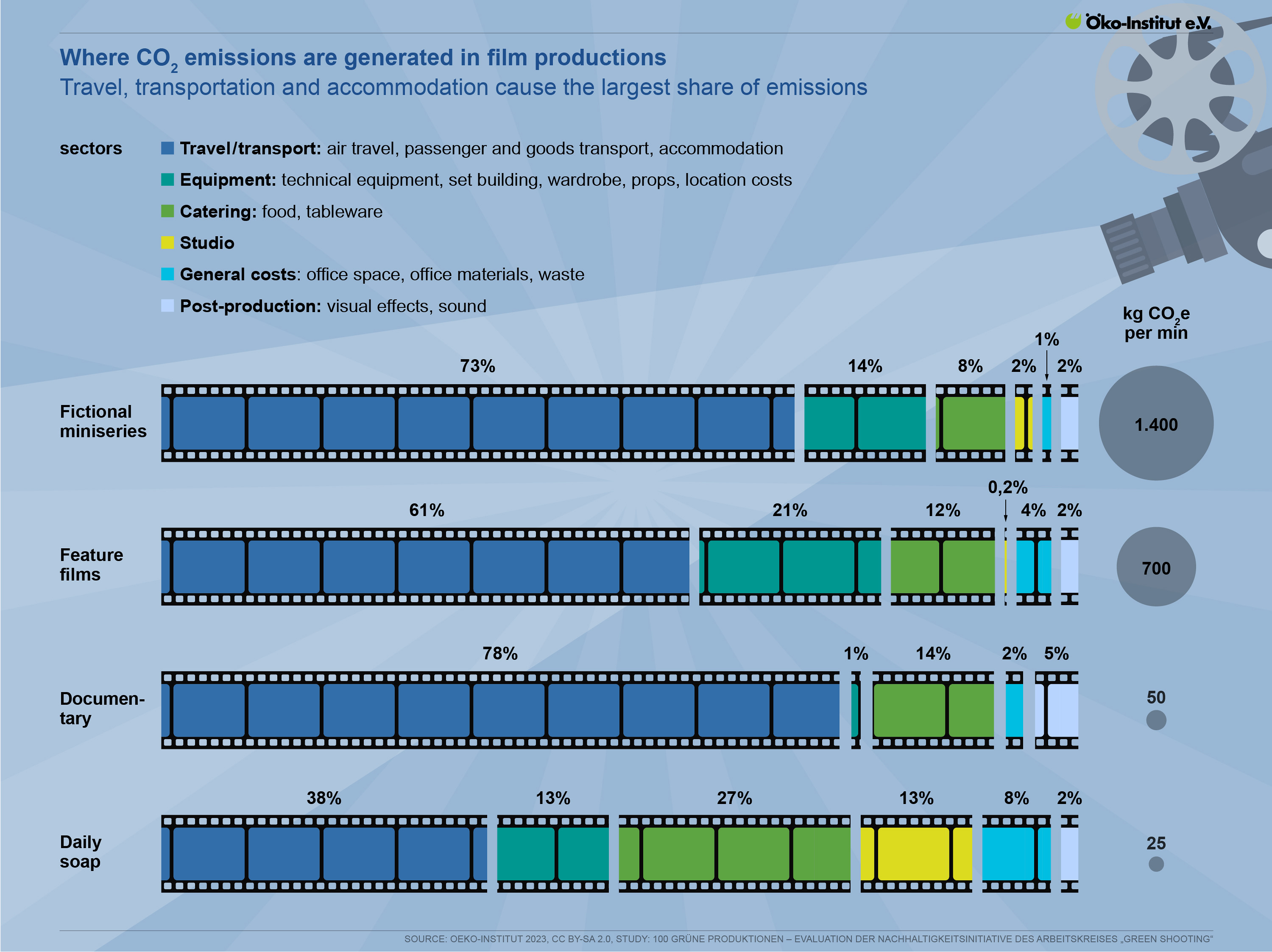Study reveals major climate change mitigation potential in film production

© plainpicture/Love Strandell
78 productions: from the big screen to TV reality shows
In all, 78 film and TV productions were involved in the “100 Green Film Productions” sustainability initiative implemented by the Green Shooting Working Group at MGF Filmförderung Baden-Württemberg, in which a set of environmental criteria had to be complied with during production. The productions were broadcast by ARD, Amazon, RTL Group, Netflix, Sky, ZDF und ProSiebenSat.1 or were screened in cinemas (for a list of the films, see link below). Just under 50% of the participating productions were feature films or TV dramas (see Figure).
Evaluation by the Oeko-Institut
Based on the emissions audits and the final reports, a research team from the Oeko-Institut conducted a scientific evaluation of the sustainability initiative on behalf of MFG Filmförderung Baden-Württemberg and thus supported the further development of the criteria. The Federal Government Commissioner for Culture and the Media provided funding for the study.
The evaluation covered a range of areas: analysis of participating productions’ greenhouse gas emissions; a quantitative and qualitative assessment of compliance with the criteria; and exemplary quantification of savings achieved by the productions through their compliance with the criteria.
Relevant factors: transport, travel, energy, filming days, catering
Emissions for each minute of film time vary depending on the format: series and feature films with high production values emit more than daily soaps, documentary features or documentary series. Greenhouse gas emissions from the production of around one minute of a series with high production values are more than 50 times higher (1,400 kg CO2-equivalents (CO2e)) than emissions from a documentary feature (25 kg CO2e).
Transport and travel produce the largest share of GHG emissions (40-80 per cent) across all formats. Equipment and catering also account for a high percentage, as do indoor heating, air conditioning and studio lighting in the case of daily soaps. Longer periods of filming do not necessary mean higher greenhouse gas emissions.
The savings are increased if climate change mitigation is built into the preparations for filming at an early stage and inputs and costs are factored in. This applies both to strategic decisions – on the location, size of team, etc. – and to operational decisions, such as the choice of caterer or vehicle hire.
Compliance with criteria
One of the mandatory criteria was that a green consultant should support the production. This expert advises on how to maximise resource efficiency and minimise emissions throughout the production process. Other mandatory criteria were the use of a carbon calculator to determine emissions, and the submission of a final report. Close to full compliance with the mandatory criteria was achieved.
The following three criteria are mandatory (Criterion 2 was classed as optional after the start of the initiative):
Criterion 1: Advice – expert support Mandatory appointment of a green consultant or, alternatively, a team member with training and experience in the field of “green shooting”; their role is to monitor and support the production process (including pre- and post-production) and advise on how to maximise resource efficiency and minimise carbon emissions based on the sustainability criteria for the 100 green productions.
Criterion 2: Carbon footprint, data collection All CO2 emissions to be determined prior to production using a suitable carbon calculator in order to validate the main fields of action, appropriate measures and outcomes. The calculator developed by MFG Baden-Württemberg and SWR can be used for this purpose. (https://mfg.greenshooting.de/de_DE/page)
Criterion 3: Final report On completion of the production, the production company produces a report describing compliance with the mandatory criteria 1-3 and other criteria (see below). The actual carbon emissions calculated after the end of production must be shown here. The final reports are scientifically evaluated.

With regard to the optional criteria, it was often possible to dispense with generators, disposable batteries and air travel and to choose eco-friendly accommodation. Compliance with the criteria proved particularly difficult to achieve in relation to green electricity for set construction and the use of low-emission cars and trucks (see Figure).

Barriers to climate-friendly filming: poor range of options, contracts, costs
Among many others identified in the study, three factors stood out as making it difficult to achieve compliance with environmental standards:
-
The poor range of eco-friendly options such as e-vehicles and charging stations created barriers to their use.
-
There was no scope to amend rented studios’ long-term electricity contracts for shorter production periods. Actors’ contracts often include a right to air travel, which undermines low-carbon mobility.
-
Higher costs were mentioned as a barrier to compliance with the criteria, mainly in relation to electricity consumption in set construction, eco-friendly hotels and local organic catering.
Climate-friendly film productions, planning and commissioning – outlook
The study shows that even productions that comply with all the criteria still produce high greenhouse gas emissions in some cases. “What we found, however, is that the sooner environmental aspects are considered in the production process – in relation to scheduling, location and staffing – the greater the scope for eco-friendly filming,” says Ina Rüdenauer from the Oeko-Institut.
However, change is also needed at a higher level and in a broader context: broadcasters and production studios need to create conditions which facilitate climate-friendly production. Not least, film funding providers and broadcasters should make compliance with environmental standards a binding criterion in commissioning and funding processes.
100 Grüne Produktionen – Evaluation der Nachhaltigkeitsinitiative des Arbeitskreises ‘Green Shooting’ [100 Green Productions – Evaluation of the “Green Shooting” Working Group’s sustainability initiative]: Oeko-Institut study
Ina Rüdenauer is a Senior Researcher in the Sustainable Products and Material Flows Division at the Oeko-Institut’s Freiburg office. Her research focuses mainly on sustainable consumption and sustainable products.
Further information
Greenshooting CO2 calculator for film and TV productions (calculates all greenhouse gases)




